Our cultural journey begins in Southern Mongolia’s Gobi region, where breathtaking canyons, sandy deserts, and majestic mountains await. We’ll embark on camelback to explore the vast sand dunes, connect with local families, capture stunning canyon vistas, and uncover the region’s hidden gems. Venturing beyond the southern highlights, we’ll delve into history at Kharkhorin, the ancient capital of the Mongol Empire, and visit the Erdenezuu monastery nestled upon its ruins.
Continuing our adventure, we’ll journey to central Mongolia to meet the renowned a local nomadic family. Here, amidst the rugged beauty of the steppe, we’ll witness nature’s raw power and immerse ourselves in the rich culture of the region.
Throughout our travels, accommodations in Ulaanbaatar and the Gobi will provide modern comforts like electricity, hot showers, and plush bedding in tourist traditional Ger camps.
May 30-June 6, June 14-21, June 18-25, June 21-28, June 28-July 5
July 2-9, July 5-12, July 9-16, July 12-19, July 16-23, July 19-26, July 23-30, July 26-Aug 3, July 30-Aug 6
Aug 2-9, Aug 6-13, Aug 9-16, Aug 13-20, Aug 16-23, Aug 20-27, Aug 23-30, Aug 27-Sept 3, Aug 30-Sep 6
Sept 6-13

You’ll have an early breakfast at the tourist camp. Then, will get transferred to the airport by drivers and tour guides. Arrive in Ulaanbaatar and driven straight to the White Stupa, a journey of about 5-6 hours. Once part of the seafloor, this escarpment resembles a white stupa, earning its name Tsagaan Suvarga (white stupa). Stretching 400 meters in length and rising 60 meters with a sheer 90-degree edge, it’s quite a sight. After rainfall, water cascades down, giving it the appearance of a massive waterfall and creating a surface reminiscent of Mars. It’s the perfect time to leisurely stroll along the White Stupa, capturing stunning photos, including drone shots, especially during the sunset.(B/L/D)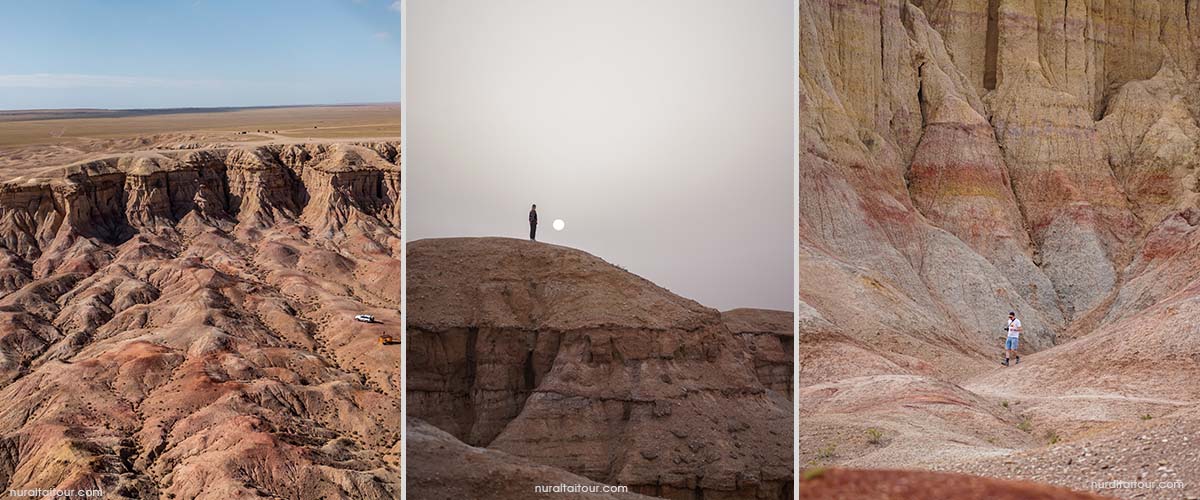
You’ll head to the Yol Valley, also known as Lammergeier Valley, in the Gobi Gurvan Saikhan Mountain National Park /Three Beauties of the Gobi/ for about 3-4 hours. This valley is a beautiful spot nestled in the Gobi desert, with thick ice almost year-round. The cliffs are incredibly high, blocking much of the sunlight, which helps the snow to stick around even in the summer. If you visit before August, you’ll encounter a glacier among the rocky cliffs as you ascend towards the ravine. Exploring the valley usually takes around 2-3 hours. For the remainder of the day, you can relax at the Mongolian Ger tourist camp, where you’ll have access to a hot shower. All the Gers are equipped with comfy mattresses and crisp white blankets.(B/L/D)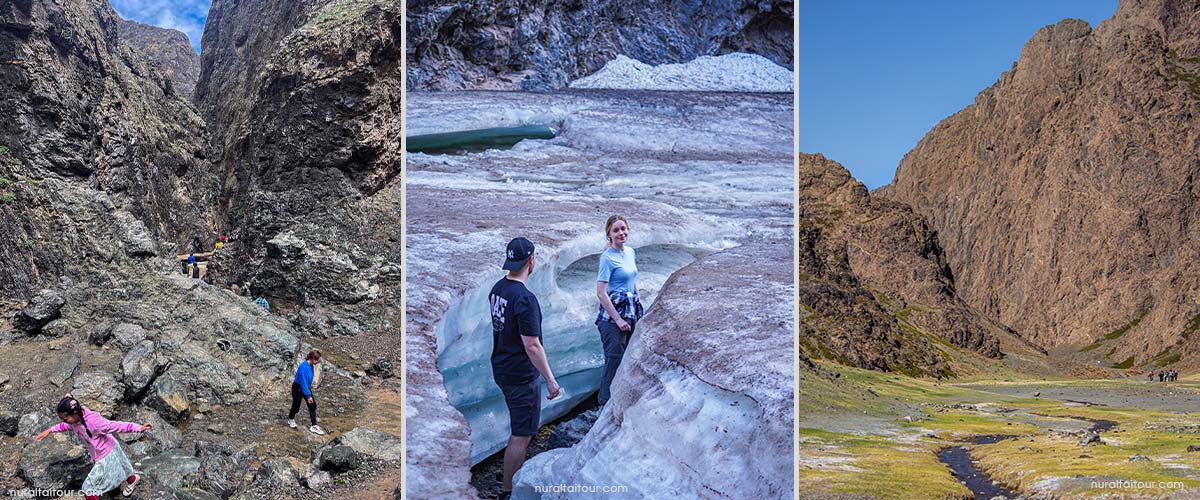
Embark on a journey to Khongoryn Els, the largest sand dune in Mongolia, towering up to 300 meters high. The drive covers about 200 kilometers, taking roughly 4 to 5 hours to reach the destination.
You’ll visit a local camel herder family, where you’ll also experience riding Mongolian Bactrian camels. As your first experience of Gobi, you’ll explore the Khongor sand dune on the camelback. The dual-humped Bactrian camels offer a smooth riding experience due to their leisurely and gentle pace, and our camel guide ensures a safe journey through the sandy terrain. You’ll also get to discover the beauty of the Seruun-Bulag oasis nestled amidst the dunes.
One of the highlights of the Khongor sand dune is climbing Duut Mankhan, also known as Sounding Dunes, for the sunset. It’s very challenging but quite safe. Climbing up is a blast, as the dune’s steep slope makes your feet slip with each step. Once you reach the summit, you’ll be treated to a breathtaking view of nature, with unusual vibrant hues of the setting sun.
It’s typical for cloud cover in the desert to be sparse, which keeps the sky clean. This gives you a chance to gaze at the countless stars that adorn the night sky. Overnight at the tourist camp with a hot shower, white blankets.(B/L/D)
You’ll drive approximately 160 km distance for about 4 hours and arrive in Bayanzag which is a famous archaeological site with its rich fossil finds, including dinosaur eggs and skeletons, which provide valuable insights into prehistoric life. Its history is deeply connected with paleontological discoveries made by American paleontologist Roy Chapman Andrews in the early 20th century.
You’ll wander through the terrain where dinosaurs once roamed, observing saksaul trees and other typical desert vegetation. The region is also famously known as Flaming Cliffs. The Flaming Cliffs are named for the vibrant red and orange tones that light up the landscape forming a breathtaking visual display. 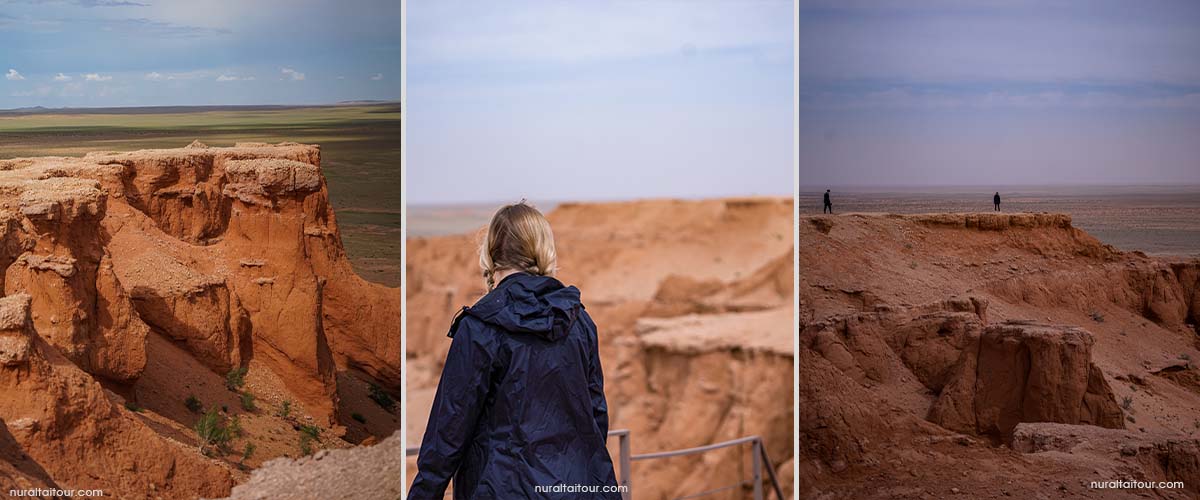 Then, you’ll depart from the Gobi to reach the Ongi Temple ruins, which once stood as one of Mongolia’s largest monasteries, hosting over 1000 monks at its peak. Unfortunately, many sections of the Ongi monastery were completely demolished in 1939 during anti-religious purges. Given the considerable distance between Kharkhorin and the Flaming Cliffs, attempting it in a single day would entail a very long drive. Therefore, you’ll spend the night relaxing at the Ongi temple ruins. Take a leisurely evening stroll through the area and spend the night at a lovely tourist camp.(B/L/D)
Then, you’ll depart from the Gobi to reach the Ongi Temple ruins, which once stood as one of Mongolia’s largest monasteries, hosting over 1000 monks at its peak. Unfortunately, many sections of the Ongi monastery were completely demolished in 1939 during anti-religious purges. Given the considerable distance between Kharkhorin and the Flaming Cliffs, attempting it in a single day would entail a very long drive. Therefore, you’ll spend the night relaxing at the Ongi temple ruins. Take a leisurely evening stroll through the area and spend the night at a lovely tourist camp.(B/L/D)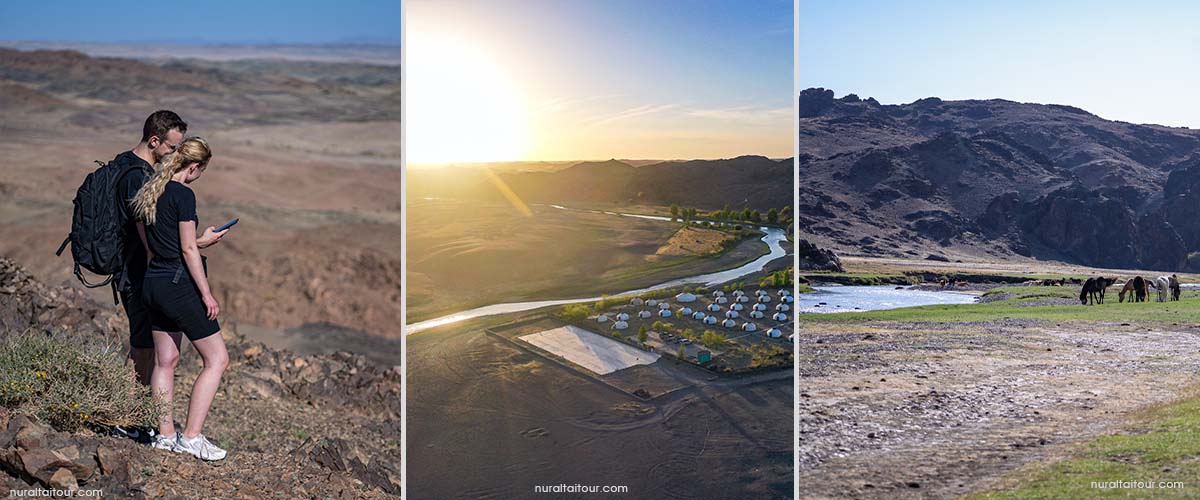
We’ll move to the heart of Orkhon valley to meet a local nomadic family to experience their daily lifestyle. The drive will take around 5-6 hours from Ongi temple ruin to the Orkhon valley and we will arrive at the Mongolian nomadic family’s dwelling. We will be greeted with warm hospitality, and in accordance with Mongolian tradition, enter their ger. They will extend their kindness and offer food. During this time, we will acquaint ourselves with the family members.
Furthermore, you’ll get involved in the cultures. Our English-speaking tour guide will facilitate communication between you and the local inhabitants. We will spend the night at the ger.(B/L/D)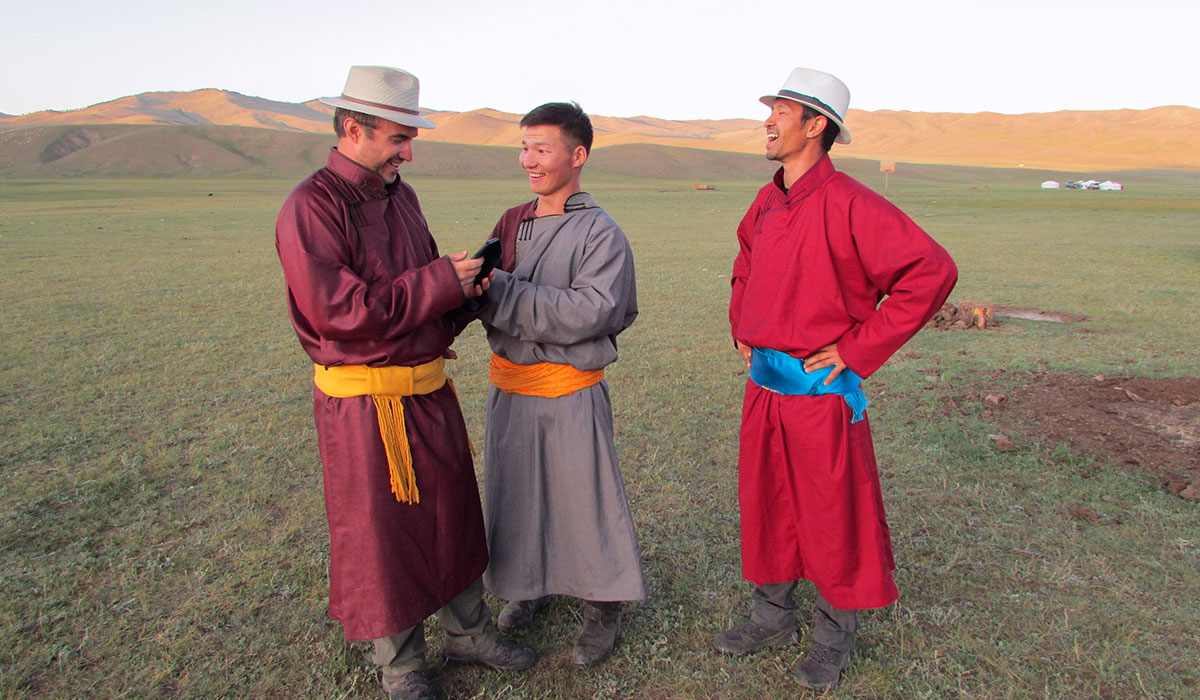
We’ll journey to the picturesque Tuvkhun temple at the mountaintop by riding horses through a stunning forested area, immersing ourselves in the serene atmosphere. We’ll arrive at a small open meadow in front of a towering rocky cliff. As we get closer to the mountaintop, the terrain becomes a bit steeper. The monastery sits on that cliff, so we’ll ascend to it using rocky steps. On the way, you’ll encounter three small temples. While exploring the monastery, you’ll come across various meditation caves and a small cave known as the “mother’s womb.” Local beliefs suggest that rolling in the womb can cleanse your body, much like being reborn. At the mountaintop, you’ll also find several ovoos and monuments dedicated to natural deities. This experience is definitely worth a try, as it offers a breathtaking display of nature from the mountaintop. Afterward, we’ll ride back to the family. Overnight.(B/L/D)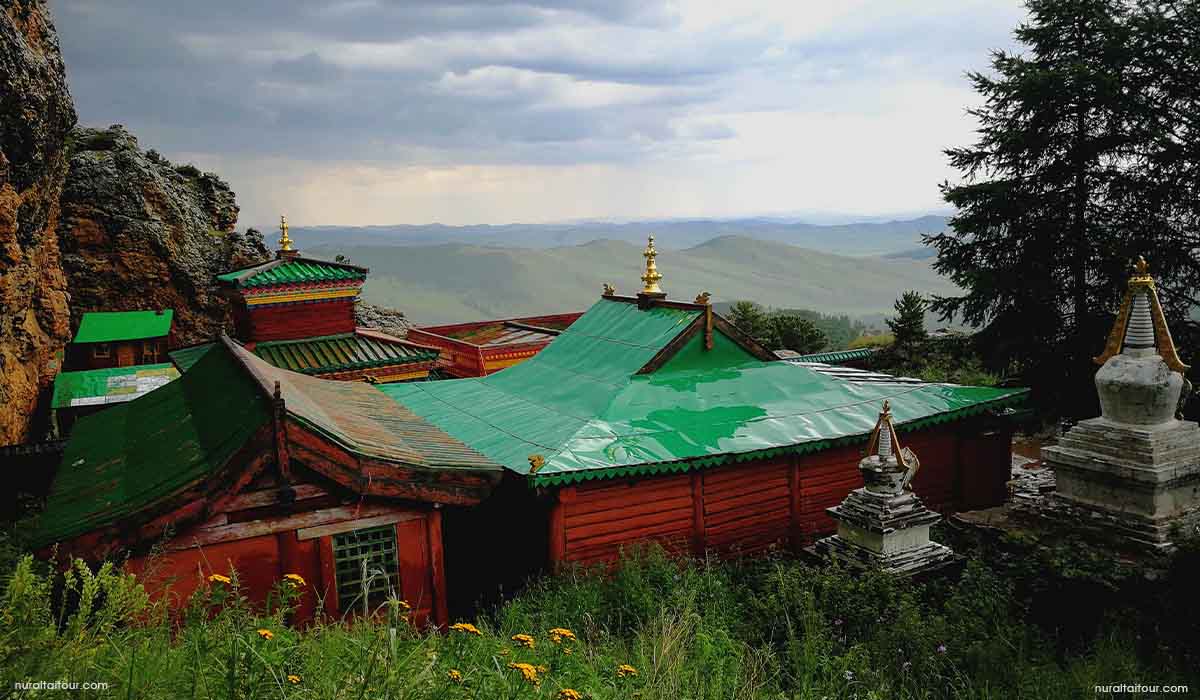
Today is a special day because you will learn about the unusual nomadic lifestyle, how nomads spend their days, and how they keep their traditions, and culture even in the present period. Generally, nomads are hardworking people, and daily tasks doing like processing milk products, milk livestock, cleaning cattle sheds, searching for high-productivity of pastures, and so on.
One of the interesting jobs in processing dairy products from a mare called Airag. Fermented horse milk is a traditional beverage, well-known in central Mongolia since it is a little more familiar than other areas. Every two hours, a mare is milked by a herder, who also confines or separates the foals. For nomadic families, using a lasso to catch foals is considered one of the most interesting activities. Furthermore, there are other activities to perform to fence cattle off at night when milking cows, the next morning. It will be the best experience when you participate in it. Traditional homemade dairy products will be instructed by the family members. Visitors will pay attention and have a chance to experience impersonally milking yak, processing milk, fermenting horse milk, making dried curd, and yak skim as well. Furthermore, there will be a mini-tournament to test your skill against locals and fellow travelers once a pre-start Khalkha archery course is given, one of Mongolia’s traditional sports. After lunch, transporting drinking water from two to three kilometers away on the mini truck can be fun.
Due to extreme weather causing climate change and drought reducing the power and endurance of both wild and farmed animals, the use of motorcycles in nomadic herding has increased instead in recent years. To feel adventurous, you can also sit behind the motorcycle and ride around the middle Mongolian plateau like the wind while herding cattle from the foothills of the mountains.
As mentioned above, adults process milk products while preparing dinner, while kids spend every evening playing knuckle-bone, horse racing, and other traditional games to have fun. 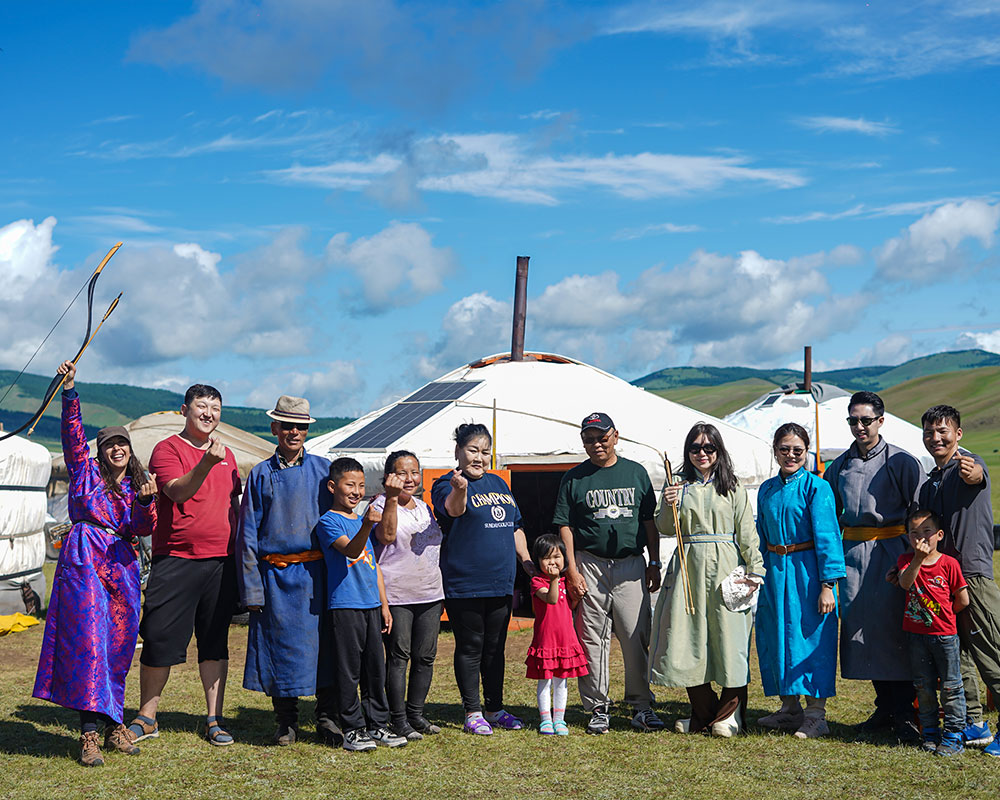 We’ll drive towards north to see ancient Erdene Zuu monastery. Kharkhorin was the capital of ancient Mongol Empire in 13th century, now one of the historical town of Arkhangai province.
We’ll drive towards north to see ancient Erdene Zuu monastery. Kharkhorin was the capital of ancient Mongol Empire in 13th century, now one of the historical town of Arkhangai province.
Dates back to the XIII Century, contruction of the “Kharkhorum” was completed at the time of Chinggis Khaan’s successor Ogodei Khaan and it was a political and trade center through which passed the legendary Silk Road, the main commerce network of whole Eurasia.
Then we’ll visit Erdenezuu Khiid – the oldest monastery in Mongolia.
Erdene Zuu Monastery has been built on ruins of ancient capital using its stones after introduction of Buddhism in Mongolia end of XVI century. Now Erdene Zuu Khiid is considered by many to be the most important monastery in the country and a museum that is open to tourists. Overnight in a tourist camp.(B/L/D)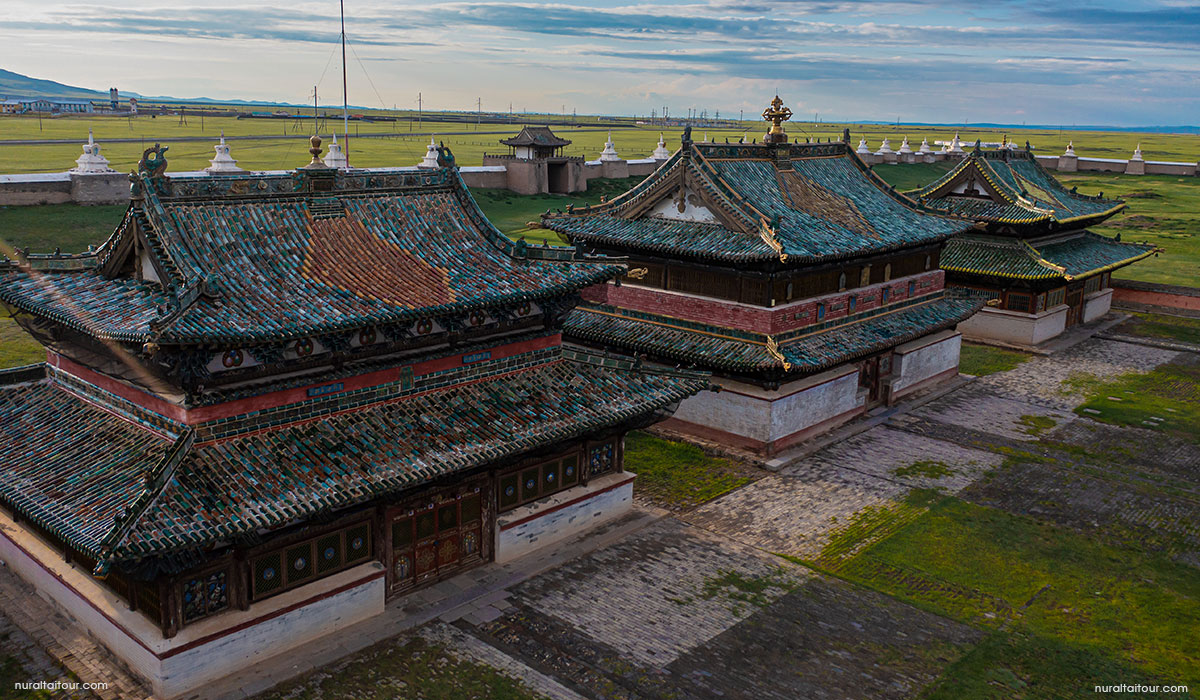
You’ll depart from Kharkhorin in the morning and drive to Khustai National Park for about 3-4 hours, arriving at noon. Known for its successful reintroduction of Przewalski’s horse, also known as the Mongolian wild horse or Takhi, into its native habitat, Khustai National Park boasts diverse landscapes including vast grasslands, rolling hills, and rocky outcrops. These provide habitats for various wildlife species such as deer, marmots, and more, in addition to wild horses.
Visitors can enjoy wildlife viewing, hiking, and learning about conservation efforts in this beautiful protected area. Afterward, we’ll head back to Ulaanbaatar on a paved road for 100km.(B/L)

nur altai tour
Hey, this is Nur. Please, leave your message. We'll answer your questions ASAP.
Any quick questions related to Gobi Desert and Central Mongolia?
WhatsApp Us
🟢 Online | Privacy policy
